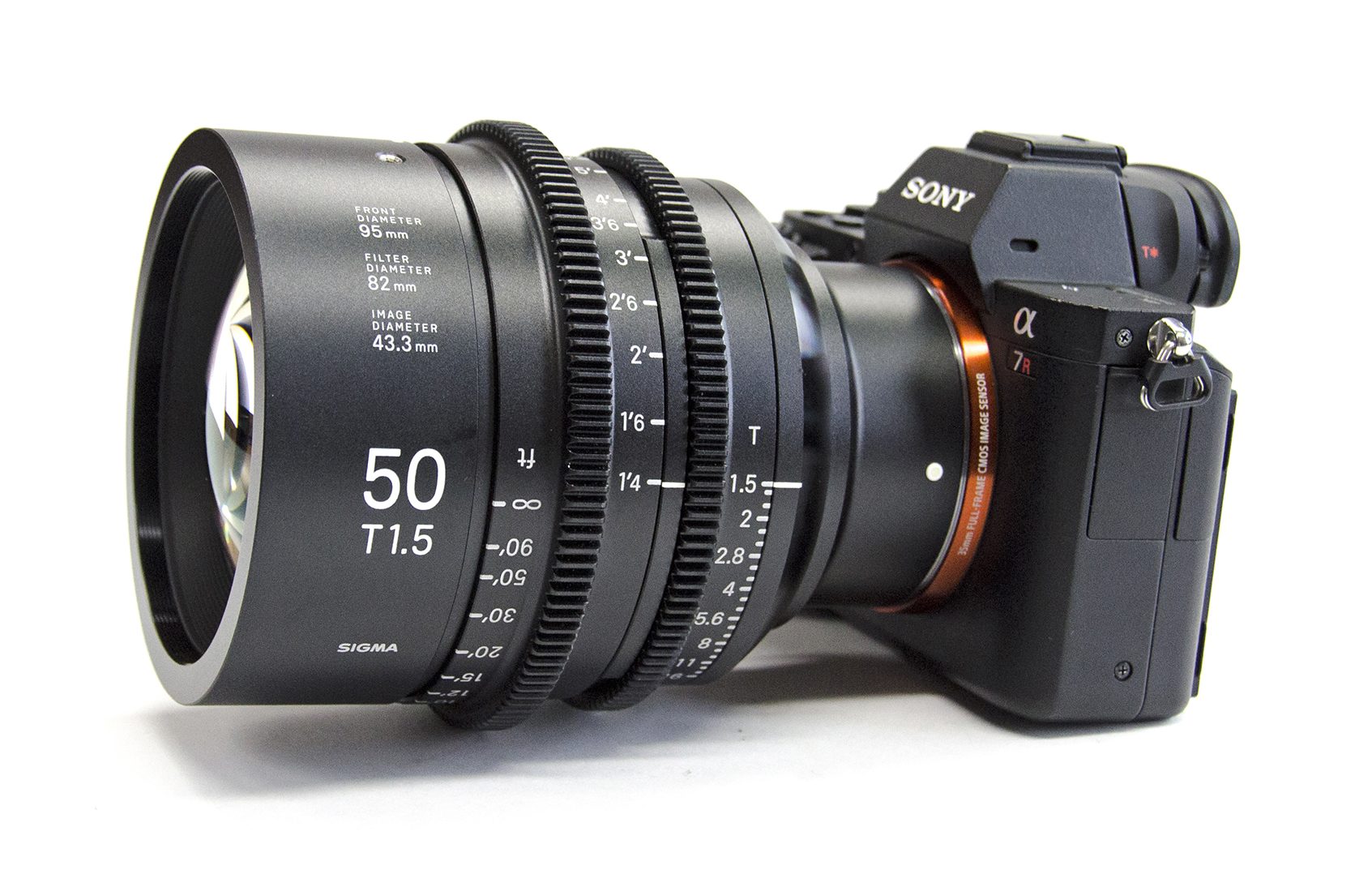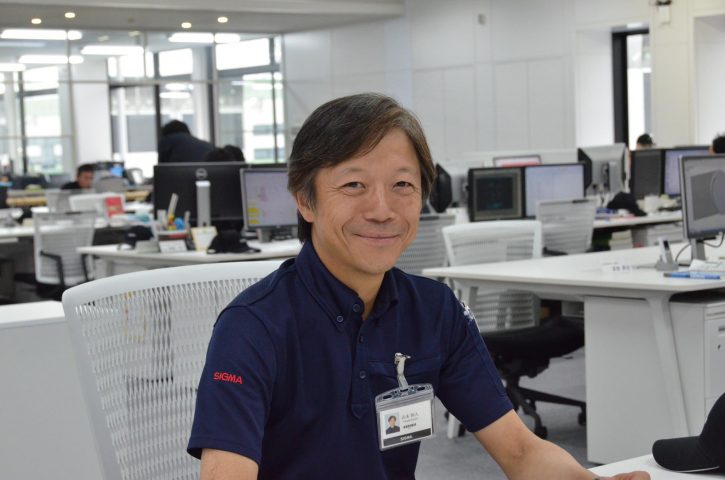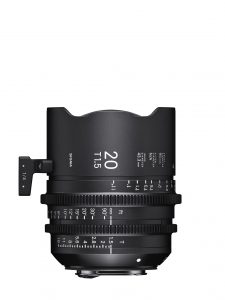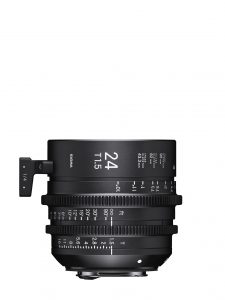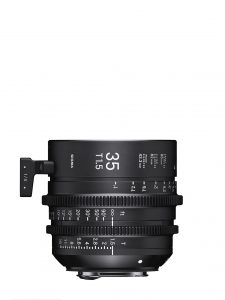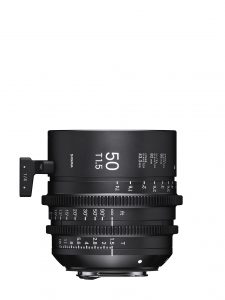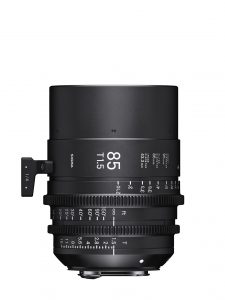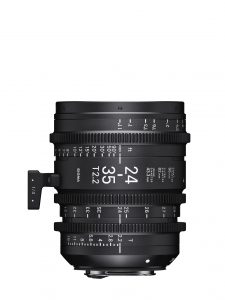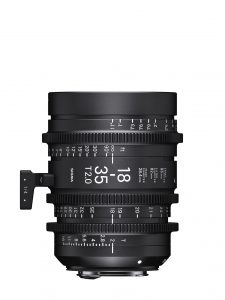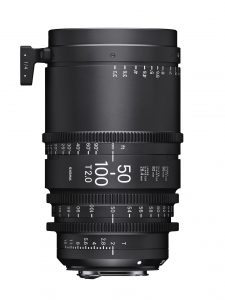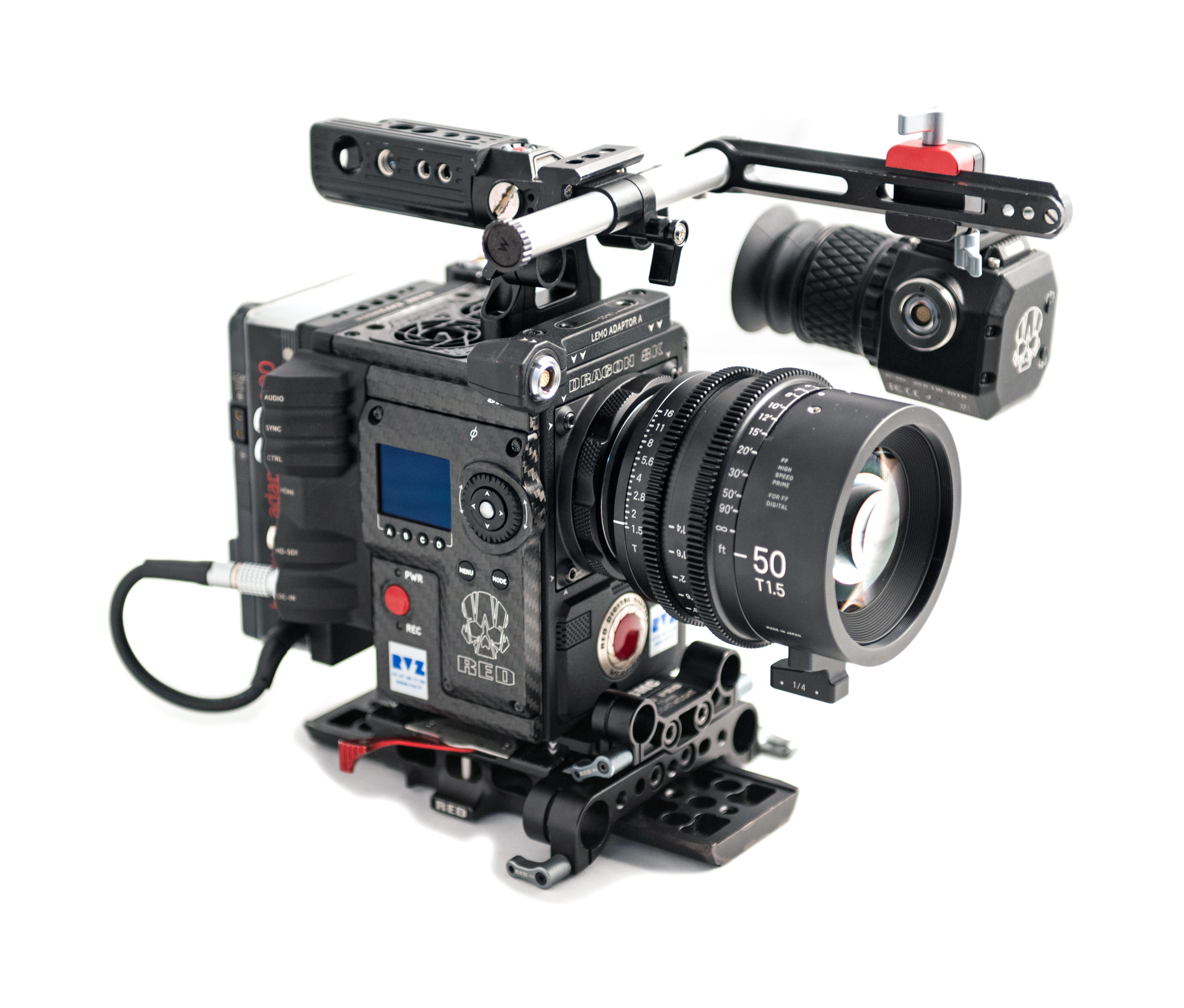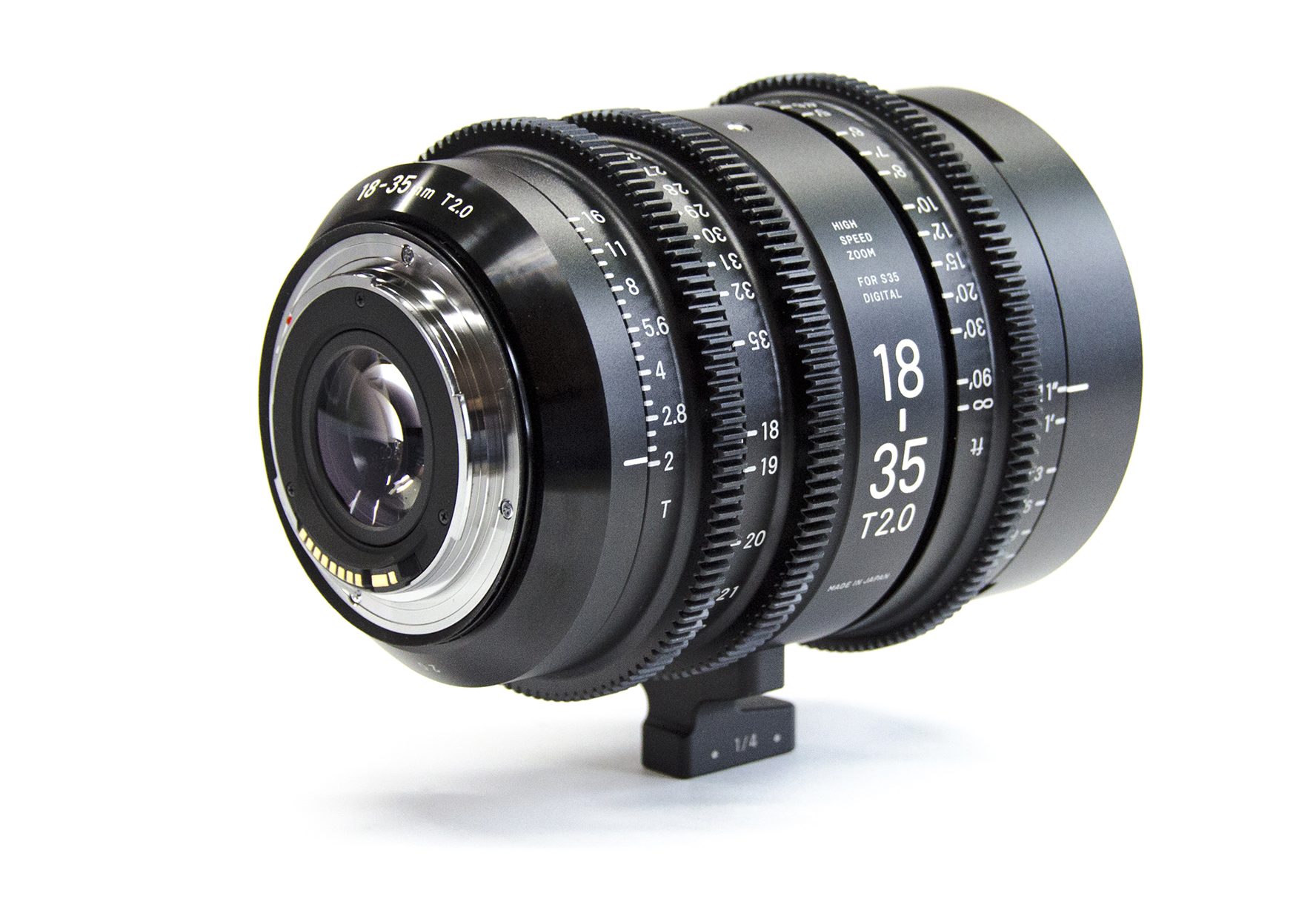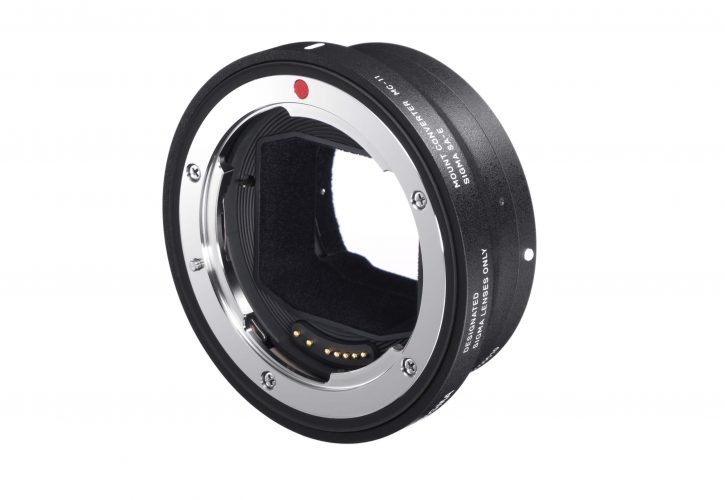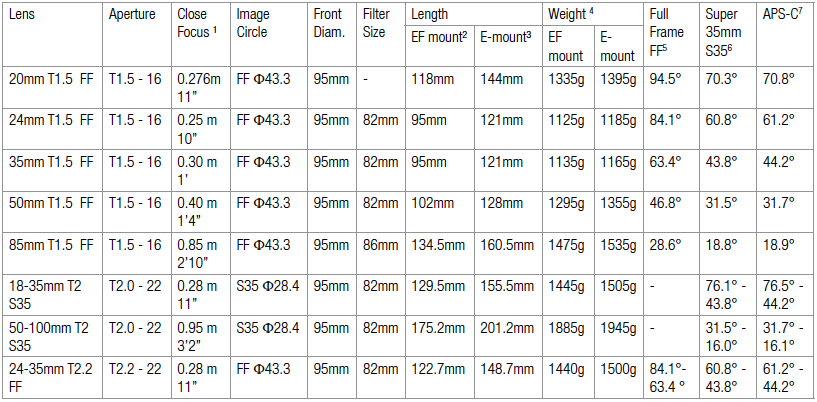
Sigma Cine Lenses: S35 18-35mm T2 and 50-100mm T2. FF Zoom 24-35mm T2. FF Primes: 20, 24, 35, 50 and 85 mm, all T1.5.
(Note how the focus and iris barrels line up and they all have the same 95mm front diameter)
Download the 20-page 3.7 MB PDF of this article — which also includes a comprehensive tour of the Sigma Factory in northern Japan and an interview with Kazuto Yamaki, CEO of Sigma.
The rumors are confirmed. The big booth at IBC makes sense: Sigma is jumping into the cinema industry with a new line of CINE LENSES. The big news is that most of them are Full Frame, High Speed, ridiculously small and incredibly light. Image quality is outstanding. These are not rehoused lenses. They come from the same factory where the superb Sigma Art DSLR lenses come from—the northern region of Japan—Aizu.
The Aizu culture of hard work, attention to detail, and tenacity is shared today by the 1,400 workers of the large Sigma factory who build approximately 1 million photo lenses each year. The 54,757 sq m factory is nestled at the foot of Mt. Bandai in a forest of emerald- green cypress. Almost all the components of Sigma lenses, from tiny screws and iris blades to large diameter front elements are made in this factory.
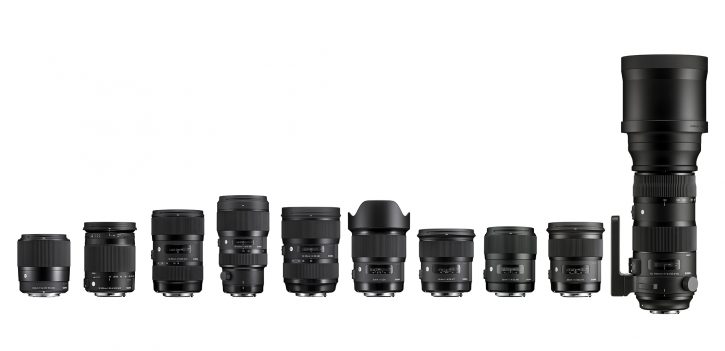
Sigma DSLR Lenses (L-R). Contemporary Series: 30mm f1.4 DC DN (mirrorless), 18-300mm f3.5-6.3 DC (APS-C) MACRO OS HSM. Art Series: 18-35mm f1.8 DC APS-C, 50-100mm f1.8 DC APS-C. 24-35 f2.0 DG Full Frame. ART Series Full Frame Primes: 20mm f1.4 DG, 24mm f1.4 DG, 35mm f1.4 DG, 50mm f1.4 DG. Sports Full Frame: 150-600mm f5-6.3 DG OS HSM.
Sigma still photography lenses come in Full Frame (DG), APS-C (DC) and Mirrorless (DN) — mostly with EF (Canon), F (Nikon), and E (Sony) mounts. Mount conversion service is available at the Aizu factory.
The flagship lenses are the Sigma Art series, primes and zooms characterized by their large aperture, high resolution, high MTF, and beautiful bokeh. Sigma Art Lenses have been described in respected still photography reviews as “spectacular” “superb build quality,” and “impressive optics.”
And now at IBC, Sigma introduces a new line of Sigma Cine Lenses. The initial set will consist of five Full Frame Primes: 20, 24, 35, 50 and 85 mm, all T1.5 — and a Full Frame Zoom 24-35mm T2.
For Super35, Sigma offers two fast zooms: 18-35mm T2 and 50-100mm T2.
Conversation with Kazuto Yamaki, CEO of Sigma
Kazuto Yamaki is the CEO. In this era of outsourcing and offshore production, it is encouraging to see Mr. Yamaki’s determination to maintain jobs and manufacturing in the company his father created in 1961. As Mr. Yamaki guided me around the factory, I was impressed how he greeted almost everyone by name. His sense of responsibly for the employment and well-being of hundreds of employees was palpable. It is a friendly place.
Why is the tour of the factory article (see PDF) so long? Never before have I been allowed to see and photograph everything in a lens factory that did everything from glass molding and polishing to assembly, from iris blades to the tiniest screws and contacts. There wasn’t a single area, machine or process that was kept secret. “Most of us in the optics business use the same machines and have the same processes,” Mr. Yamaki said. “The differences come from the design, the skill of the people who build the lenses, and the attention to detail.
Before touring the facility, Mr. Yamaki and I had a conversation at his desk in the open floor plan office he shares with designers, planners and management teams.
Jon Fauer: Please tell us about the company history.
Kazuto Yamaki: The opening of IBC 2016 marks the 55th anniversary of Sigma Corporation. Our company was founded on September 9, 1961 by my father, Michihiro Yamaki, when he was 27 years old. His family was quite poor. As a student, he worked for a small optics company, aligning the prism in binoculars. After graduating, he worked for a small optics as a corporate executive. One day, the company went bankrupt. The owner disappeared suddenly with the company’s money and with his mistress. Some of the suppliers asked my father to work with them as a consultant. It went well and he then decided to start a factory of his own in Tokyo. I remember him saying to me that he had no plans to become an entrepreneur or company owner. He started the business simply because of the request of his suppliers.
His two sisters and my mother worked in the company. It’s a family business. At first, they purchased parts from suppliers and just assembled lenses. They built interchangeable lenses for SLR cameras. As you can imagine, business can be very challenging for a start-up company—mainly cash flow. But my father was very fortunate to have a line of popular items. He had the idea to develop rear and front converter lenses. Until then, most of the tele- or wide angle converters were designed for specific lenses because the diameter of the front element is different from one lens to another. He had the idea to develop universal converters that could be used for many cameras and lenses. This became a big hit for Sigma and helped grow the business.
How large is Sigma Corporation?
Today, we have 1600 employees. Our turnover last fiscal year was 43 billion Japanese yen. That’s about $400 million U.S. It’s a medium-sized company. But I don’t want to make it too big. I think this is a good size to maintain state of the art technology, quality and build interesting products. We have subsidiaries in Germany, America, China, Hong Kong, UK, France and Benelux. We also make cameras with Foveon sensors, based in San Jose, California.
Sigma headquarters are in Kawasaki. The factory is in Aizu. Our philosophy is small office, big factory. This was the philosophy of my father, which he repeated to us many times. In the Kawasaki headquarters, we have administration, finance, accounting, human resources, sales, marketing and customer support. But most of the employees are engineers. We have a large optical, mechanical and electronic design teams as well as development, product design and product planning teams.
How many optical and mechanical designers do you have?
Approximately 200 people work in our headquarters and about 160 people are engineers. Over 75 percent are engineers. The optical design team consists of different specialties. Some engineers specialize in ghosting and flares. We call them ghost busters. They run simulations from the initial design and advise the optical and mechanical designers during the entire process. We have a very experienced chief designer. Planning interchangeable lenses for DSLRs requires a lot of team work among the optical, mechanical and electronic designers because we need to put motors inside the lens to drive focus, iris and zoom. The teams have to work very closely from the beginning because each parameter can influence size, weight and optical performance.
With that we began the factory tour…which you can see in the PDF…but let’s cut to the chase and look at the Sigma Cine Lenses.
Sigma FF and S35 Cine Lenses
Sigma is in a very good position to enter the motion picture market. Kazuto Yamaki’s “small office” was able to streamline decision-making, and the 1500 lens-makers at the “big factory” in Aizu are able to build everything in-house, from the smallest set screws and iris leaves to the aspherical elements and barrels.
I sense that when the boss noticed a demand for high-performance cine lenses at reasonable prices, the company was able to respond quickly. Sigma planners and designers realized that professional cine equipment was built in relatively limited numbers, with longer R&D cycles, and higher costs. It was a completely different business model than the faster-paced, price-driven, trend-conscious consumer photography market they were accustomed to. Sigma had long been in the enviable position of being able to design high-quality lenses and produce them in large quantities. And large quantity production lowers costs to consumers.
Sigma already had a great deal of experience building the acclaimed Global Vision lineup of still photography lenses for 50-megapixel-plus, ultra-high resolution cameras. They were able to use that knowledge in this new line of cine lenses.
By using similar optical elements as the Sigma Art DSLR series of lenses, these cine lenses benefit from economies of production. The mechanical design is completely new.
3 categories of Sigma Cine Lenses
FF (Full Frame) High-Speed Prime Line
The initial set of five FF Primes will be 20, 24, 35, 50 and 85 mm— all T1.5. They cover Full Frame format of 24x36mm (43.3mm image diagonal), although recent tests suggest they cover a larger area. Of course, they work on both Full Frame and Super35 cameras: a 20mm T1.5 remains just that in both formats.
Sigma Cine lenses come with a choice of EF (Canon), E-mount (Sony), and PL mounts.
FF (Full Frame) Zoom Line
The Sigma Cine 24-35mm T2.2 is a wide, compact, lightweight, high-quality zoom for Full Frame and, of course, Super35. This is the wide, short zoom that will be helpful for Steadicam, handheld, rigs, car shots, helicopter mounts, drones, as well as studio establishing shots. The 24-35 T2.2 comes in EF or E-mount. Not PL.
S35 (Super 35mm) High-Speed Zoom Line
Two Sigma Cine High-Speed S35 Zooms will ship in the initial release: 18-35mm T2 and 50-100mm T2. They come in EF (Canon), E-mount (Sony), or PL mount.
Lightweight and Compact
Sigma Cine lenses are all lightweight, compact and fast. This is quite an accomplishment for Full Frame models.
Dust-proof and splash-proof
They have the same dust-proof and splash-proof construction as the Sigma 150-600mm F5-6.3 DG OS HSM | Sports lens. Each ring and mount is sealed to help prevent water and dust from entering.
The body is rugged. No plastic parts.
Luminous paint
Lens designation, index lines, witness marks and scales use luminous paint to aid in changing and operating the lens in the dark.
82mm front filter
The front filter is standardized at 82mm on most models.
95mm front diameter
The front diameter of all the lenses is 95mm.
Gears
In each product line, the position of the lens gears and barrels are the same for all lenses. This saves time mounting lens motors and accessories. Each lens has an industry-standard 0.8M gear pitch.
Barrel rotation
All lenses have focus barrels that rotate 180°. Focus is guided by cams for smooth focus pulling. The zoom ring rotates 160° on all zoom lenses. The iris ring is linear—with a constant distance between T-stop marks. It rotates 60°. There are no click steps.
EF, PL and E-mount
Sigma Cine Lenses are available in Canon EF mount, Sony E-mount, and PL (except 24-35mm T2.2 FF).
Mount Conversion Service
Niels Bohr said, “Prediction is very difficult, especially if it’s about the future.” One thing is certain: we don’t know what mount the industry will settle on in its Full Frame future.
So, it’s nice to know that you can change your mind about lens mounts on Sigma Cine Lenses. They have been addressing this situation for some time with their still lenses. Sigma’s Mount Conversion Service will be available for the new cine lenses. Customers will be able to have their lens mounts swapped for a reasonable fee. It’s a good way to future-proof one’s investment in lenses.
One way to hedge your bets between EF and E-mount is to get the lens with an EF mount. Then, purchase a Sigma MC-11 MOUNT CONVERTER to use Sigma’s EF mount lenses on a Sony E-mount camera body.
Electronic contacts
The EF and E-mount have electronic contacts so the lens can communicate with the camera body (focal length, focus distance, aperture, etc.)
Lens support
A removable lens support comes standard with all models.
Rollout
For the first phase, it is expected that Sigma will release two zoom lenses toward the end of 2016. Another zoom lens and 5 prime lenses will be released in 2017 onward. A Sigma executive said, “We will develop additional zoom and prime lenses, and the lens lineup will be enriched further. The latest release information will be updated on our official website (sigma-global.com).”
IBC
Sigma will have a big booth at IBC in Amsterdam and I can only imagine the number of cinematographers lining up with requests for additional lenses in their favorite focal lengths.
Visit Sigma at their IBC Stand 12.B68 www.sigma-global.com
Sigma Cine Lens Specs
Sigma Cine Lenses will be available in EF (Canon), E-mount (Sony), and PL (all except 24-35mm T2.2 Full Frame Zoom)
1. Close focus distance is measured from the image plane
2. Front to EF-mount flange
3. Front to E-mount flange
4. Without lens support foot
5. Horizontal angle of view for a full-frame camera aperture (aspect ratio 1:1.5,dimensions 36 mm x 24 mm / 1.42“ x 0.94“)
6. Horizontal angle of view for a super 35 digital cinema camera aperture (aspect ratio 1:1.8,dimensions 24.6 mm x 13.8 mm / 0.97“ x 0.54“)
7. Horizontal angle of view for an APS-C camera aperture (aspect ratio 1:1.5,dimensions 23.7 mm x 15.7 mm / 0.93“ x 0.62“)
Specifications are subject to change

